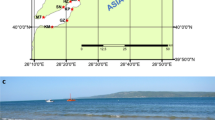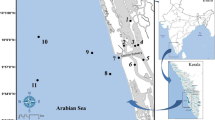Abstract
Meiobenthic and macrobenthic oligochaetes were collected from two depths in Lake Päjänne and examined together with environmental data in which two environmental gradients can be seen. Numbers of Piguetiella blanci, Aeolosoma quaternarium and Aeolosoma hemprichi were positively correlated with oxygen saturation and negatively correlated with total phosphorus and COD suggesting that these species are indicators of oligotrophic conditions. Numbers of Amphichaeta leydigii, Specaria josinae and Vejdovskyella comata were positively correlated with total phosphorus which implies that these species prefer eutrophic conditions. The last three species and Dero digitata showed positive correlations with COD and organic sedimentation, which suggests that they also indicate organic loading. A decrease in aeolosomatid biomass was seen with increasing phosphorus and organic loading. The average body size of detritus-feeding naidids in the upper part of the profundal zone was reduced by organic loading, and more clearly eutrophication, which emphasizes the importance of including meiobenthic oligochaetes in pollution investigations. Of the naidid and aeolosomatid species, Chaetogaster langi preferred the greatest depths of the profundal zone while most of the other species were more abundant at 20 m rather than at the maximum depth. Clustering of the oligochaete taxa supported these observations and clustering of sampling stations based on oligochaete variables generally corresponded to clustering based on environmental data.
Similar content being viewed by others
References
Brinkhurst, R.O., 1974. The benthos of lakes. The Macmillan Press Ltd, London and Basingstoke, 190 pp.
Cranston, P.S., 1990. Biomonitoring and Invertebrate Taxonomy. Envir. Monit. Assess. 14: 265–273.
Maatela, P., J. Paasivirta, J. Särkkä & R. Paukku, 1990. Organic chlorine compounds in lake sediments. II. Organically bound chlorine. Chemosphere 21: 1343–1354.
Milbrink, G., 1980. Oligochaete communities in pollution biology: the European situation with special reference to lakes in Scandinavia. In R.O. Brinkhurst & D.G. Cook (eds), Aquatic Oligochaete Biology. Plenum Press, New York, 433 pp.
Rapport, D.J., 1990. Challenges in the detection and diagnosis of pathological change in aquatic ecosystems. J. Great Lakes Res. 16: 609–618.
Särkkä, J., 1989. Meiobenthic naidid and aeolosomatid oligochaetes from the profundal zone, and relations of species to eutrophication. Hydrobiologia 180 /(Dev. Hydrobiol 51): 185–190.
Särkkä, J., 1992. Lacustrine profundal meiobenthos as an environmental indicator. Hydrobiologia 243/244 (Dev. Hydrobiol. 79): 333–340.
Thiel, H., 1975. The size structure of the deep-sea benthos. Int. Revue ges. Hydrobiol. 60: 575–606.
Warwick, R.M., N.R. Collins, J.M. Gee & C.L. George, 1986. Species size distributions of benthic and pelagic Metazoa: evidence for interaction? Mar. Ecol. Progr. Ser. 34: 63–68.
Warwick, R.M., T.H. Pearson & Ruswahyuni, 1987. Detection of pollution effects on marine macrobenthos: further evaluation of the species abundance/biomass method. Mar. Biol. 95: 193–200.
Weston, D.P., 1990. Quantitative examination of macrobenthic community changes along an organic enrichment gradient. Mar. Ecol. Prog. Ser. 61: 233–244.
Wiederholm, T., 1980. Use of benthos in lake monitoring. J. Wat. Pollut. Cont. Fed. 62: 537–547.
Author information
Authors and Affiliations
Rights and permissions
About this article
Cite this article
Särkkä, J. Lacustrine, profundal meiobenthic oligochaetes as indicators of trophy and organic loading. Hydrobiologia 278, 231–241 (1994). https://doi.org/10.1007/BF00142331
Issue Date:
DOI: https://doi.org/10.1007/BF00142331




